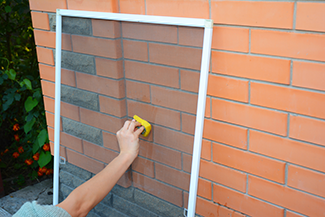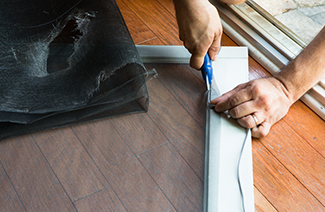Screening the Right Screen for Your Home
Screening the Right Screen for Your Home
One of the most overlooked components of a house is the window and door screens. Homebuyers generally accept the screens that are there and don’t really think about them until they become damaged and need to be replaced. But are the screens the right ones for your lifestyle?
Sun Screens
 The function of a sun screen is to prevent UV rays from ever reaching your windows. Sun screens work in three ways:
The function of a sun screen is to prevent UV rays from ever reaching your windows. Sun screens work in three ways:
- Shading efficiency | the amount of shade created between the screen and exterior pane of glass.
- Reflectivity | the ability of the screen to reflect the sun’s rays away from the window, which keeps heat from touching the glass.
- Absorption | the heat that is absorbed into and held in by the screen material and then dispersed back into the air and away from the glass.
For maximum effectiveness, sun screens must be built to fit the exterior of your window with the spine facing out; this creates an insulating air space between the window and sun screen. Vinyl coated sun screens are very effective because the material can be produced cost effectively. The average lifespan of screen material is seven to ten years for fiberglass and over ten years for vinyl coated screens, in which time the screen has already paid for itself several times over.
Sun screens are only as strong as their frames. Quality frames will last as long as you own your home so consider strong metal frames when shopping for sun screens. Make sure the frame is constructed of aluminum measuring 1" inch wide, 7/16 deep, and .025 thick. Make sure the corners are made of aluminum also, not plastic which has a tendency to dry out and break over time.
Sun screen material will not block the view from inside during the day, but it does prevent anyone from looking inside. At nighttime this effect is reversed if there is a light on inside the home.
Security / Safety Screens
Security / safety screens offer a physical barrier and a break-in preventative measure. Featuring a high-tensile stainless steel mesh system primarily designed for security purposes, security screens prevent forced entry or break-ins while maintaining ventilation. They can be easily incorporated to different types of windows and doors.
Not all security screens are created equal. The quality is largely determined by the type of materials that they are made from. Made of stainless steel (the ideal material), their construction, installation process, frame, hinges, and locking system are engineered so they can't be pried open by thieves.
Pet Screens
 If you have pets, then you are well aware of the damage their claws and teeth can do to the screen’s mesh. K9 of Mine suggests removing existing screens and replacing them with a heavier-duty variety, which will withstand your pet’s claws and teeth such as Phifer PetScreen ®. Made in the U.S.A. from strong, vinyl-coated polyester, Phifer PetScreen® is engineered and woven to be tougher, more resilient and more durable against tears caused by pets.
If you have pets, then you are well aware of the damage their claws and teeth can do to the screen’s mesh. K9 of Mine suggests removing existing screens and replacing them with a heavier-duty variety, which will withstand your pet’s claws and teeth such as Phifer PetScreen ®. Made in the U.S.A. from strong, vinyl-coated polyester, Phifer PetScreen® is engineered and woven to be tougher, more resilient and more durable against tears caused by pets.
A variety of their screens and installation tools can be found at most home supply stores. The cost varies on the strength of the mesh and the size of the roll. For example, a 48 in. x 84 in. Black Pet Screen is $19.98 a roll and a 48 in. x 100 ft. Black Pet Screen is $235.20 a roll at the same store.
Other Screen Benefits
The tighter the weave, the more benefits a screen can offer.
- Shoo fly! If you live near horse property, livestock or a lake you will want to keep the flies and mosquitoes at bay.
- Prevent falls from opened windows. This is especially important in homes with kids, the elderly, and pets.
- Ventilation: Even finely woven mesh allows natural airflow into the home efficiently.
- Curb appeal: Thanks to its fine mesh, security screens blend beautifully with almost any kinds of windows and doors. It also offers curb appeal, especially if you are selling your home.
DIY Replacing Screens
Tools required:
- Tape measure
- Yard stick
- Utility knife
- Spline roller (The spline is a rubber retention band that secures the mesh to the frame.)
Removing the screen:

Although manufacturers use different systems to secure their screens, most rely on metal clips attached to the outside of the window frame that can be loosened with a screwdriver. Other types of attachments are flat springs on the side of the screens. Applying pressure against the screen frame will compress the springs and leave enough room on the opposite side of the frame to pull the frame out.
Replacing the torn screen:
- Lay the frame on a flat surface.
- Remove the rubber retention spline and the torn screen.
- Cut out a cardboard insert the size of the inside of the screen frame. This does not have to be exact, just close. This will help support the screen and result in a tighter screen installation Lay new screen material over the frame and cardboard insert. Special note: Buy the best material you can afford and approximately 4-6 inches larger than the frame.
- Do not try to stretch the screen tight; just lay it out wrinkle free.
- Start a new spline and roll it in with a spline rolling tool, being careful not to roll off the spline and into the screen. This will tear the screen.
- Hold the repaired screen up and inspect for wrinkles in the material, remove spline and adjust as needed.
- Using a sharp utility knife, trim off excess screen material, being careful not to cut the screen inside the frame perimeter.
- When re-installing your screen frame, do so in a way that the screen is held off of the glass, with the spline facing out. The space created between the screen and window will further insulate your windows.
Washing Sunscreens
Josh Lawlor, president, Clearco Window & Carpet Cleaning, a Rosie-Certified Partner, does not recommend pressure washing sun screens because you will likely be left with unsightly line patterns once the screens dry. "It is better to clean sun screens with a dry brush first, then use a large, soapy sponge for washing. Next rinse with a hose and let them drip dry," he recommends.
Clearco uses 303 Aerospace Protectant after cleaning the screens.
Home Maintenance To-Do | #Screens
Podcast
We tackle the Home Maintenance To-Do on #Screens and a frequent pool-owner question: How do I keep ducks from landing and swimming in my pool!? We also cover questions on insulating a block home, replacing a roof whirly bird with a solar exhaust fan (why we don't suggest it) and how to cut a laminate countertop.
###
Photo Credits:
- Shutterstock
RELATED CONTENT:
- Rosie-Certified Partner: Clearco Window & Carpet Cleaning
- Rosie-Certified Partner: Arizona Sun Screens
- Blog: Good Quality Windows Can Provide Safety And Beauty
- Blog: 20 Tips For Making Sure Your House Is Secure While You're On Vacation
- DIY FAQ: How Do Sun Screens Block Solar Heat Gain?
- DIY FAQ: Are Replacing Torn Sun Screens A Diy Project?
- DIY FAQ: Dual Pane Window Condensation
- DIY FAQ: Window Maintenance
- DIY FAQ: Clean Windows Help Bring Spring Indoors!
- Podcast: Window Security Adds Beauty And Value To Your Home
